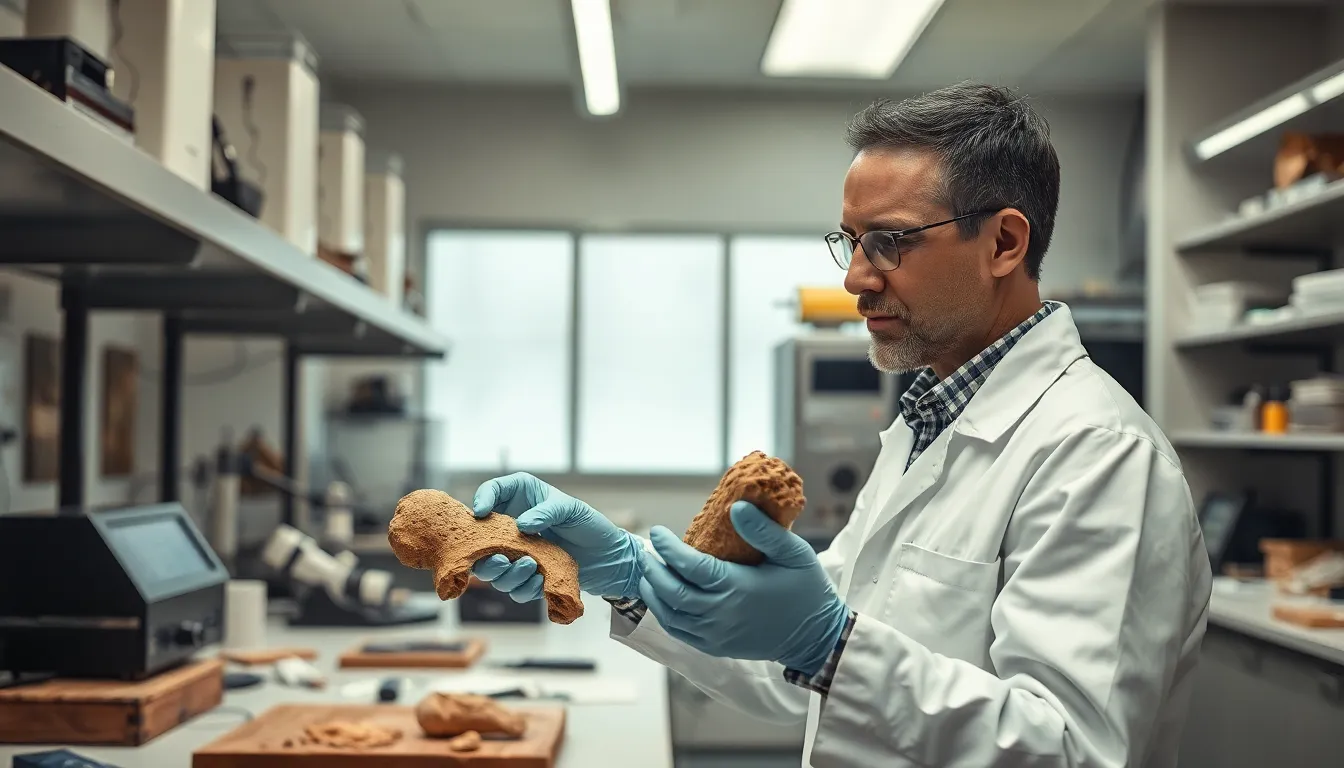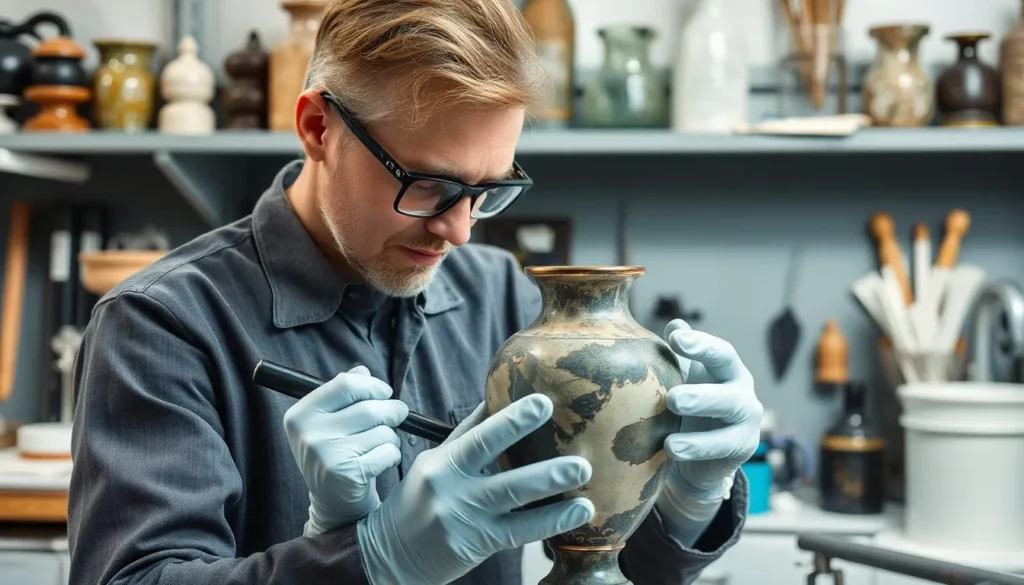Table of Contents
ToggleWhen it comes to preserving history, museum quality restoration is like giving artifacts a spa day—minus the cucumbers on their eyes. This meticulous process breathes new life into cherished pieces, ensuring they remain as captivating as the day they were created. Whether it’s a centuries-old painting or a fragile piece of pottery, skilled restorers work their magic, bringing back the beauty while maintaining authenticity.
Imagine a world where priceless treasures fade into oblivion. Not on their watch! Museum quality restoration not only safeguards the past but also educates future generations. So, if you think your grandma’s vintage vase deserves a makeover, think again—it’s not just a vase; it’s a piece of history waiting to shine again. Join the journey of transforming the old into the extraordinary, and discover why museum quality restoration is the unsung hero of cultural preservation.
Understanding Museum Quality Restoration
Museum quality restoration focuses on preserving historical artifacts through skilled techniques. The objective remains to rejuvenate items while ensuring authenticity and integrity.
Definition and Importance
Museum quality restoration refers to the meticulous process of repairing and conserving cultural artifacts. This practice plays a pivotal role in maintaining the visual and historical significance of various items. By addressing damage and wear, experts enhance the longevity of artifacts. Such restoration efforts safeguard cultural heritage for future generations to study and appreciate. Recognizing the importance of this work encourages a deeper understanding of history through tangible items, fostering a connection between the past and present.
Key Principles of Restoration
Key principles of restoration include authentic repair, minimal intervention, and documentation. Authentic repair focuses on using original materials and techniques whenever possible. Minimal intervention emphasizes preserving the item’s integrity, avoiding unnecessary alterations. Documentation serves to chronicle each restoration step, providing a clear history of the artifact’s condition. Furthermore, reversibility is a critical principle, ensuring any restoration can be undone without harm. Experts follow strict ethical guidelines to maintain authenticity and value, balancing restoration with respect to the original creator’s intent.
Techniques Used in Museum Quality Restoration

Various techniques enhance museum quality restoration, ensuring artifacts remain preserved for future generations. These methods focus on maintaining an item’s integrity while addressing damage.
Conservation Methods
Conservation methods play a crucial role in museum quality restoration. Cleaning surfaces carefully removes dirt without causing further harm. Stabilizing materials reinforces the structural integrity of fragile artifacts. By filling in gaps with compatible materials, experts restore an object’s appearance while ensuring long-term preservation. Some techniques even involve applying protective coatings that safeguard against environmental factors. Each method adheres to strict guidelines to maintain the artifact’s historical value.
Modern Technologies in Restoration
Modern technologies offer innovative solutions for museum quality restoration. Digital imaging allows for detailed documentation of an item’s condition, aiding in planning restoration efforts. 3D scanning helps create replicas, enabling study and display without risking original pieces. Using ultraviolet light assistance reveals hidden details and marks for more informed restoration. Additionally, advanced materials and tools enhance precision in repairs. Incorporating these technologies enables restorers to achieve results that respect both the artifact’s authenticity and its historical significance.
Case Studies in Museum Quality Restoration
Museum quality restoration showcases the intricate balance between preserving artifacts and enhancing their historical significance. Several notable projects exemplify the skill and dedication involved.
Notable Restoration Projects
The restoration of the Sistine Chapel ceiling stands out as an iconic endeavor. It involved meticulous cleaning, revealing vibrant colors obscured by centuries of grime. Another significant project includes the restoration of the Dead Sea Scrolls, where experts carefully stabilized fragile fragments to prevent further deterioration. The extensive effort allowed scholars to study these ancient manuscripts more closely. The conservation of King Tutankhamun’s burial mask also illustrates commitment to preserving history. Technicians used advanced techniques to repair damage from a botched restoration attempt, ensuring its safe display for future generations.
Lessons Learned from Restoration Efforts
Each restoration project provides insights into best practices and ethical considerations. Understanding the importance of documentation emerged as a crucial lesson; it ensures transparency throughout the process. The necessity for using original materials became apparent in several cases, reinforcing the idea that authenticity is paramount. Flexibility in techniques allows restorers to adapt responses to individual artifacts and their unique challenges. Listening to the artifact often yields significant results, leading to innovative approaches in restoration that respect the original creator’s intent and intent.
Challenges in Museum Quality Restoration
Museum quality restoration faces several challenges that require careful navigation by experts. Preservation of historical integrity is paramount.
Ethical Considerations
Ethical considerations significantly impact restoration processes. Restorers must respect the original creator’s intent while deciding on interventions. Authenticity remains a critical aspect; therefore, techniques used must align with established ethical guidelines. Documentation of every step in the restoration process helps maintain transparency and accountability. Adhering to these principles ensures the artifact’s story remains intact without compromising its cultural value.
Balancing Restoration with Preservation
Balancing restoration with preservation proves challenging for professionals. While enhancing an artifact’s appearance is important, it cannot come at the expense of its historical context. Minimal intervention techniques play a crucial role in this balance, allowing restorers to repair damage while still maintaining authenticity. The use of reversible methods guarantees that any alterations can be undone if necessary. Achieving this delicate equilibrium ensures that artifacts not only remain visually appealing but also retain their historical significance for future generations to appreciate.
Museum quality restoration plays a crucial role in preserving our cultural heritage. By employing skilled techniques and adhering to ethical standards, restorers ensure that artifacts not only retain their beauty but also their historical significance. This meticulous process fosters a deeper appreciation for the stories behind each piece, encouraging future generations to connect with the past.
As advancements in technology continue to evolve, the possibilities for restoration become even more exciting. The ongoing commitment to preserving authenticity while enhancing visual appeal underscores the importance of this field. Ultimately, museum quality restoration is not just about repairing items; it’s about safeguarding history for all to cherish and learn from.



